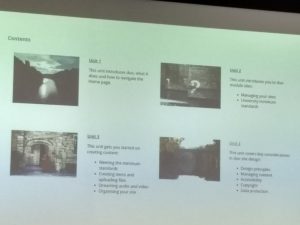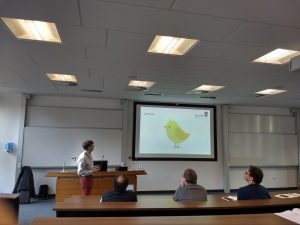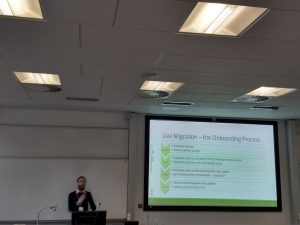In January I attended the Durham Blackboard Users’ Conference. This was the 18th running of the event by Durham University and the first I have attended. Each conference has a unique theme and this years was based on the classic Spaghetti western, The Good, the Bad and The Ugly. The two day conference featured a number of talks, demos and presentations highlighting what is good bad and ugly with Blackboard.
Before I cover some of the sessions, I have to say it was an exceptionally well run conference. The team at Durham have put a great deal of work into not only the event, but the social aspect following the conference. A highlight was a private tour followed by dinner in the rather glorious surroundings of Durham Castle.


Alternative to Turnitin?
Moving onto the programme, the Durham team managed to arrange a number of interesting and varied Blackboard sessions over the course of the two days. One of the first sessions I attended was by URKUND, one of the conference sponsors. URKUND, which has a large presence in Europe, offer a plagiarism detection service that compares submitted documents against around 11 million student papers, journals, periodicals and books all over the web. Click on the video below for an overview of URKUND:
URKUND have been working with Blackboard to create a building block that uses Blackboard’s Mashup tool so that assignments are sent directly to URKUND for checking. From the demo, it looks like there are a few key differences from Turnitin. Firstly, URKUND doesn’t have the option to remove bibliography from similarity report which is something you can easily do in Turnitin. It also creates two columns per assignment in the grade centre. One column for the assignment and one for the similarity report. Are there advantages of using URKURD over Turnitin? Well, it is difficult to say at the moment. For long term users of Turnitin, would they allow you to take your institution repository and place it in a rival system or would you have to start again from scratch? Another consideration is the user experience and whether it offers the same functionality as Turnitin. At the moment that remains to be seen.
Self-directed Blackboard Course
As a Blackboard training provider, it is always interesting to see what services other institutions are offering. Candace Nolan-Grant from Durham University gave an interesting presentation on a self-directed Blackboard course that introduced new staff to their Blackboard platform (duo). The course, available to all new staff and anyone on request, was designed for those unable to attend face to face training or preferred online learning.

The course aim was to help staff with the basics of Blackboard to ensure they meet university minimum standards and crucially, understand Blackboard from a student and staff perspective. The initial idea was to create a sandbox for all staff. However, Candace commented that this ‘clogged’ up the system so they limited to new staff. Durham produced some stats after rolling out this introduction course. They had 79 unique visitors. 62 visited more than the first page. However, they only had 18 return visitors, possibly due to the staff completing the course after one visit. Interestingly they had zero posts in the blog they created highlighting a challenge most institutions have getting staff and students to engage with interactive tools. Overall, it is a good first attempt at developing self-directed training.
Upgrading to the latest release of Blackboard Learn
There was an interesting presentation by Jonathan Knight from the University of Keele discussing how they have radically changed their process for dealing with upgrades to the latest versions of Blackboard Learn. Historically Keele, like most institutions, are a version or two behind the current Blackboard release, preferring to wait for others to test new releases and explore features before making them available to staff. Jonathan used the analogy of the canary down a mine to demonstrate this point.

Over the last few years they have changed that policy and now prefer to run the latest release with all the features turned on. Jonathan argued that introduction of SAAS Ultra and updates every two to four weeks makes Blackboard the ‘canaries’ finding all the bugs and doing all the testing in their latest version. For Jonathan, he found that with Blackboard backfilling bug fixes into a version a year old can sometimes lead to side effects and in turn impact functionality in the older version of Learn. Jonathan also suggested that not having to spend time doing rigorous testing has freed up their teams time to focus on new developments. Personally, I feel it a bit of a brave move going to the latest release as you never know what might work or more importantly not work. Interestingly when questioned on change management procedures, Jonathan mentioned it is not something they deal with. Jokingly (or rather ominously), Jonathan ended his presentation saying if he is not around at next year’s conference then you know that this method has not worked. Maybe best not to rush to the latest version yet.
Moving to Managed Hosting – A review
One of the final presentations of the conference was by Chris Boon from City College Norwich on their move to a managed hosted solution. There were a couple of key drivers for Chris. Firstly, the increased number of services that have moved to the cloud meant it was a good time to review the hosting option. Secondly, it would hopefully resolve what he described as ‘Thursday slowdown’ problem where the system would be temperamental for no obvious reason. Chris spoke about the on boarding process which you can see in the image below before moving onto disadvantages and advantages.

The main issue they have had was losing access to the database. Previously they were able to fix things via database queries or run simple reports on database. However, on the flipside they no longer have same the performance issues they had before. Furthermore, upgrades have become significantly easier and less labour intensive. This has also had the knock on effect of freeing up more time for other developments. It was a somewhat positive end to the conference knowing that the move to managed hosted can bring a number of potential benefits.